Lesson 13.1: Genetics of Populations
Lesson 13.1: Genetics of Populations
Lesson Objectives
Analyze the relationship between Darwin’s work and Mendel’s discoveries.
Explain the goal of population genetics.
Describe the relationship between genes and traits.
Differentiate between genes and alleles.
Connect alleles to variations in traits.
Distinguish environmental effects on gene expression from allelic variations in genes.
Describe the relationship between mutations and alleles.
Explain the causes and random nature of mutation.
Compare rates of mutation in microorganisms to those in multicellular organisms.
Analyze the ways in which sexual reproduction increases variation.
Relate mutation and sexual reproduction to natural selection.
Explain why populations, but not individuals, can evolve.
Define a population’s gene pool.
Distinguish between a population’s gene pool and a gene pool for a single gene.
Analyze the usefulness of the gene pool concept.
Explain how to determine allele frequencies.
Define evolution in terms of allele frequencies.
Discuss what is meant by a population which is fixed for a certain gene.
Show how allele frequencies measure diversity.
Evaluate the significance of a change in allele frequency
Introduction
If you have ever taken something apart to find out how it works, you will understand biol- ogists’ delight in exploring, since Darwin’s findings, how evolution actually works. Darwin gave us the keys to unlocking this mystery by describing natural selection and common an- cestry as a scientific explanation for the similarities and differences among the millions of Earth’s species – living and extinct. However, his theory depended on the ideas that traits could vary, and that variations were heritable – and even Darwin was puzzled as to how this might work. Another biological giant, Gregor Mendel, was a contemporary of Darwin’s, but his now-famous work with pea plant inheritance was not widely known or appreciated until after both scientists had died.
During the 20th century, “re-discovery” of Mendel’s work stimulated extensive research in genetics, and the identification of DNA as the universal genetic material of life, brought “heritable variation” into sharp focus. A branch of the new field of Population Biology (discussed in the Populations Chapter) finally combined what Mendel and Darwin had begun separately - the exploration of population genetics and the evolution of populations.
Genetics of Populations
You have studied genetics, DNA, and Darwinian evolutionary theory in previous chapters. You have had the opportunity to learn far more about biology than either Darwin or Mendel could imagine. You are prepared, then, to join biologists in exploring how evolution works. You know that biologists have massive amounts of evidence that natural selection and evolution happen. This chapter will explore what we know about how molecules, genes, and populations change – with the ultimate goal of understanding how the “Origin of Species” produced the vast diversity of life on Earth.
Genes and Alleles
As you’ve learned, each cell of an organism contains all the information needed to build the entire organism in the DNA of its chromosomes (Figure 13.1). A gene is a segment of DNA which has the information to code for a protein (or RNA molecule) (Figure 13.2). For many genes, the protein product controls or at least contributes to a particular trait. For example, enzymes are proteins which are important in the biochemical reactions controlling many cellular processes.
For example, the gene for the enzyme tyrosinase controls the chemical reaction which makes melanin, a brown-black pigment which colors the skin and hair of many animals, including humans. The gene is the “recipe” for tyrosinase; tyrosinase is the protein, and the trait is coloring of the skin or fur. The rabbit in Figure 13.3 has brown fur because its DNA contains a gene for tyrosinase.
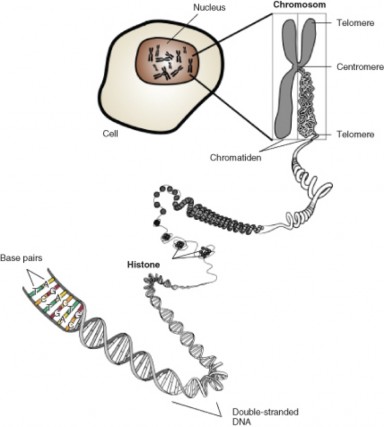
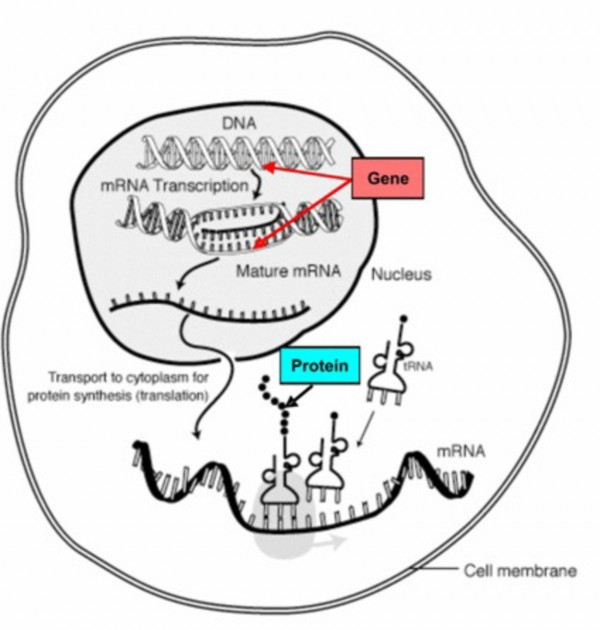
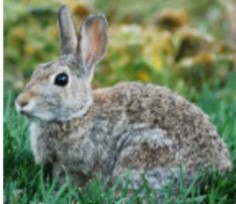
Genes often have different forms – slightly different nucleotide sequences – known as alleles. In some rabbits, an alternative form of the gene for fur color makes non-functional tyrosinase. A change in the sequence of As, Ts, Cs, and Gs changes the sequence of amino acids in the protein and alters or destroys its activity. This allele is recessive, and can cause lack of pigment – an albino rabbit (Figure 13.4). We will refer to the dominant gene for brown fur as B, and the recessive gene for albinism as b.
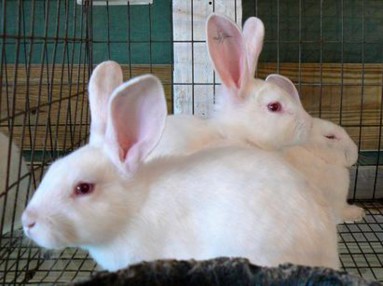
Recall that Mendel showed that humans and rabbits have two copies of each gene, or ”herita-
ble unit” – one from each of our parents. The two alleles we received make up our genotype. For simple Mendelian traits, our genotype determines our physical appearance, or pheno- type, for that trait. A rabbit having two copies of the mutant, recessive gene cannot make tyrosinase – or melanin; its genotype is bb, and its phenotype is albino. A rabbit having either one or two copies of the gene for tyrosinase makes melanin; its genotype is either Bb or BB, and in either case, because B is dominant, its phenotype is brown. Brown rabbits which have different alleles (genotype Bb) are heterozygous, and brown rabbits with identical alleles (BB) are homozygous. Albino rabbits with identical recessive alleles (bb) are also homozygous.
Keep in mind that the environment can influence the expression of a gene – its transcription and translation to produce a protein. By preventing or promoting the expression of certain genes, the environment can cause variation in traits, but note that this influence is not at all goal-directed and does not result in heritable change. If you do not water or fertilize your garden, the plants will be short and stunted, but their small size is not a heritable change. Let’s return to rabbits to see how this kind of variation happens at the level of genes and molecules.
A third allele for rabbit fur coloration codes for a form of tyrosinase which is temperature- sensitive. At low temperatures, the enzyme makes melanin normally. However, higher temperatures denature the enzyme in the same way that cooking changes egg white; at higher temperatures, the enzyme is misshapen and cannot make melanin. The rabbit in Figure
is homozygous for temperature-sensitive tyrosinase. The main part of its body, which has a higher temperature, is white because its tyrosinase does not work at high temperatures. The tips of the rabbit’s ears, nose, and feet, however, are black, because the enzyme can work at the slightly lower temperatures of these extremities. What do you think such a rabbit would look like if it developed in the arctic? The tropics?
In conclusion, heritable variations, which Darwin knew were necessary for natural selection, are determined by the variety of alleles, or different forms of genes, which build proteins. The environment may add to the variety of phenotypes by influencing their expression, but the genes themselves remain unchanged. Only genes and their alleles can be sources of heritable variations in traits.
Sources of Variation
Genetic variation results from the diversity of alleles. How do alleles form?
You may recall that mutations change the sequence of nucleotides in DNA. Mutations can alter single nucleotides or entire chromosomes Figure 13.6, and they are the sole source of new alleles.
Even a single nucleotide substitution can cause major changes in an organism; Figure 13.7 shows the molecular and cellular effects of the well-known substitution mutation which causes
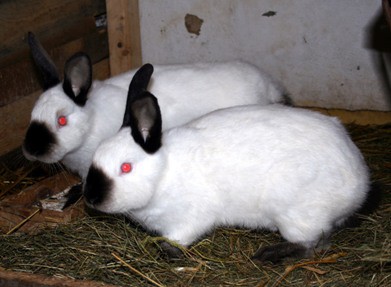
sickle-cell anemia in humans.
Caused by ultraviolet or ionizing radiation, certain chemicals, or viruses, mutations occur entirely by chance; they are not in any sense goal-directed. Usually, they reduce an organ- ism’s fitness - its ability to survive and reproduce. However, many mutations are neutral; they have no effect on an organism’s fitness. A few may actually improve fitness. Sickle-cell hemoglobin (Hemoglobin S – see Figure 13.7) prevents malarial infection, so in equato- rial environments where malaria is prevalent, one copy of the Hemoglobin-S allele increases survival and reproduction.
New alleles arise only by chance mutations, yet without them, there would be no diversity and no evolution. Although they are rare due to repair mechanisms, mutations provide the creative potential for adaptation to environmental change.
Rates of mutation depend largely on reproductive rate, and are highest in bacteria and viruses. HIV, for example, can produce over one trillion new viruses per day, and each replication of its genome provides an opportunity for mutation. Their high mutation rates explain why viruses and bacteria so often become resistant to drug treatments.
Mutations resulting in heritable variation for multicellular organisms happen constantly, but at a lower rate. In part, this is because mutations in body cells do not affect the DNA in eggs and sperm. While this prevents many damaging mutations from dooming offspring, it also reduces diversity and the potential for adaptation to changing environments. Sexual reproduction, however, compensates at least in part for this loss.
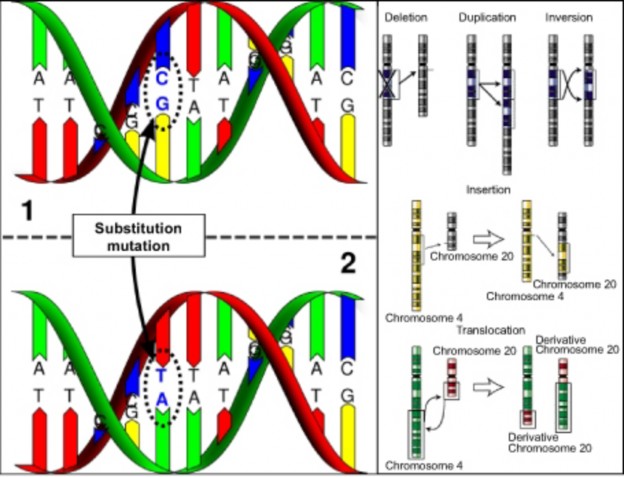
as in chromosomal mutations (B). (9)
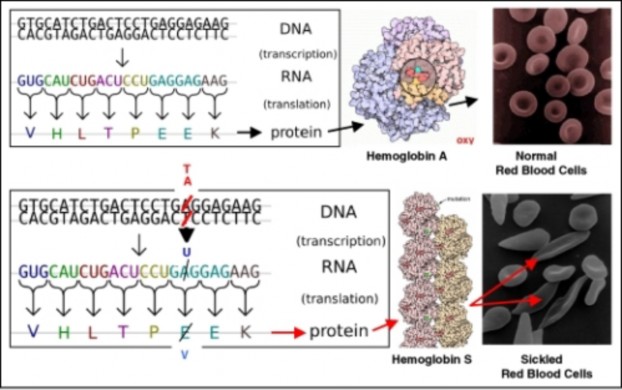
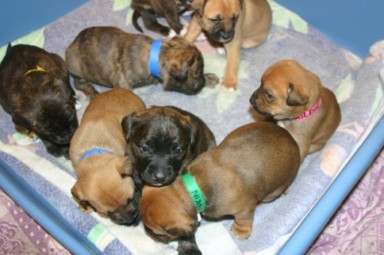
Although sexual reproduction cannot produce new alleles, meiosis and fertilization shuffle alleles from past mutations into new combinations Figure 13.8. As Mendel demonstrated, genes (which he called “factors”) segregate and sort independently during the formation of eggs and sperm (return to the Mendelian Genetics if needed), and fertilization is random. The result is that – by chance – each offspring has a unique combination of alleles – a tremendous source of variation and raw material for natural selection.
Populations and Gene Pools
Individuals do not evolve. Natural selection may affect an individual’s chance to survive and reproduce, but it cannot change the individual’s genes. However, a population – a group of organisms of a single species in a certain area – evolves when natural selection imposes differential survival on individuals within it. Population genetics studies populations at the level of genes and alleles in order to discover how evolution works.
If we consider all the alleles of all the genes of all the individuals within a population, we have defined the gene pool for that population. Gene pools contain all the genetic variation
that raw material for natural selection – within a population. The gene pool for a rabbit population, for example, includes alleles which determine coat color, ear size, whisker length, tail shape, and more (Table 13.1). If a population geneticist wants to focus on the variation in an individual gene, she/he may look at the gene pool of all the alleles for that gene alone.
Consider a population of 100 rabbits, including 10 albinos and 90 brown rabbits. The proportion of each phenotype is a measure of variation in this population, but it does not show the true genetic diversity. The gene pool does. Two populations of 10 white and 90
brown rabbits – with identical phenotypic diversity - could differ, because brown rabbits could be either homozygous or heterozygous.
Rabbits, like humans, are diploid. Therefore, each population’s gene pool for coat color contains 200 alleles. The 10 albinos in each population contribute a total of 20 b alleles to each gene pool. However, if population #1 has 40 heterozygotes and population #2 just 20, their gene pools differ significantly.
In population #1, 50 homozygous dominant individuals contribute 100 B alleles, and the 40 heterozygotes contribute 40 more. The heterozygotes also contribute 40 albino b alleles. Thus, population #1 contains a total of 140 B alleles and 60 b alleles.
Population #2, on the other hand, has 70 homozygous dominant rabbits, which add 140 B alleles to the 20 from the heterozygotes – a total of 160 B alleles. Only 40 b alleles are present in the gene pool, so genetic diversity is lower. The use of gene pools allows population geneticists to see variation and the influence of natural selection in detail.
Table 13.1: Table of Phenotypes and Genotypes in Two Rabbit Populations
Phenotypes Number of
each phenotype
Genotypes Number of
each genotype
Alleles con- tributed
to gene pool
Total gene pool
Rabbit Pop- ulation #1
90 BB 50 100B 140B


90 Bb 40 40B + 40b

10 bb 10− 20b 60b
Phenotypes Number of
each phenotype
Table 13.1: (continued)
![]()
Genotypes Number of
each genotype
Alleles con- tributed
to gene pool
Total gene pool
![]()
Rabbit Pop- ulation #2
90 BB 70 140B 160B


90 Bb 20 20B + 20b

10 bb 10− 20b 40b
As Darwin saw, populations are the units of evolution. As Mendel showed but Darwin could not have seen, heritable units, which we now know as alleles, determine the amount of variation within a population. A measure of this variation is the population’s gene pool. Once again, individuals cannot evolve, but it is the individual organism that adapts to its environment. It is the gradual accumulation of a series of adaptations - through genetic change - in a lineage from the population that is evolution.
Allele Frequencies
Our analysis of the rabbit populations (Table 13.1) showed that the relative numbers of various alleles are the best measure of variability in a gene pool (or a population). Population geneticists calculate the proportions, or frequencies, of each allele in order to study changes in populations. In fact, a change in allele frequency is the most precise measure of the process of evolution.
An allele’s frequency is the fraction (expressed as a decimal) of a population’s gene pool made up of that particular allele. In rabbit population #1 above, the gene pool for coat color included 200 alleles, 140 of which were B. The frequency of allele B for population #1 is 140/200 = 0.7. Because frequencies must total 1.0, and the only other allele is b, the frequency of allele b is 0.3. (Alternatively, we can calculate the frequency of allele b by dividing the number of this allele by the total number of alleles: 60/200 is again 0.3.) In population #2, 160 of 200 alleles are B, so the frequency of allele B is 0.8, and the frequency of allele b is 0.2.
If all the members of a rabbit population (#3) are homozygous brown, the frequency of B is 1.0, the frequency of b is 0, and there is no diversity. Allele B is said to be fixed, and until a mutation occurs, no possibility for evolution (with respect to this particular gene) exists. A population with frequencies of 0.5 for B and 0.5 for b would have maximum diversity for this two-gene system.
Any change in those frequencies across generations would reflect evolution of the population
the subject of the next lesson.
Lesson Summary
Population genetics studies populations at the level of genes and alleles in order to discover how evolution works.
Genes - segments of DNA - determine traits by coding for enzymes that control chemical reactions.
Many genes have several different forms known as alleles.
Alleles are responsible for the variation in traits.
The environment can affect the expression of some genes, but variations induced by the environment are not heritable.
Mutations – changes in single nucleotides or entire chromosomes - are the sole source of new alleles.
Ultraviolet or ionizing radiation, chemicals, or viruses cause mutations - in an entirely random way.
Rates of mutation are high in rapidly reproducing viruses and bacteria, allowing them to adapt quickly to changing environments. An example is drug resistance.
Rates of heritable mutations are lower in multicellular organisms because only germ cell mutations are passed on to offspring.
Sexual reproduction recombines existing alleles through meiosis and random fertiliza- tion, so that each offspring is unique.
Mutations and sexual reproduction provide the variety which is the raw material for natural selection.
Individuals experience natural selection, but not the genetic changes of evolution.
Populations evolve through genetic change.
A population’s gene pool includes all the alleles of all the genes of all the individuals within it.
A gene pool for a single gene includes all the alleles of that gene present in all individ- uals.
Analysis of a gene pool can reveal variation which is not visible in phenotypes.
Changes in allele frequency measure the process of evolution.
Allele frequency is the decimal fraction of a population’s gene pool made up of that particular allele.
A gene pool containing only one type of allele is fixed; it lacks variation and potential for evolution, at least until mutation occurs.
For a gene with two alleles, allele frequencies of 0.5 indicate maximum variation.
Any change in allele frequency reflects evolution of a population.
Review Questions
Describe the relationship between genes and traits.
Explain the goal of population genetics.
Differentiate between genes and alleles.
Distinguish environmental effects on gene expression from allelic variations in genes.
Describe the relationship between mutations, alleles, variation, natural selection, and chance.
Compare rates of mutation in microorganisms to those in multicellular organisms.
Explain why populations, but not individuals, can evolve.
Distinguish between a population’s gene pool and a gene pool for a single gene.
Explain how to determine allele frequencies.
Evaluate phenotype, genotype, and allele frequencies as measures of variation, as raw material for evolution, and as a measure of evolution.
Further Reading / Supplemental Links
http://library.thinkquest.org/19037/population.html
https://www3.nationalgeographic.com/genographic/
http://darwin.eeb.uconn.edu/simulations/simulations.html
http://chroma.gs.washington.edu/outreach/genetics/sickle/sickle-bean.html
Vocabulary
allele An alternative form or different version of a gene.
allele frequency The fraction (usually expressed as a decimal) of a population’s gene pool made up of a particular allele.
evolution A change in the frequency of an allele (or genetic makeup) in a population.
fitness The ability of an organism with a certain genotype to survive and reproduce, often measured as the proportion of that organism’s genes in all of the next generation’s genes.
gene A segment of DNA which codes for a protein or RNA molecule; a unit of inheritance.
gene pool Within a population, the sum of all the alleles of all the genes of all the indi- viduals.
genotype The genetic makeup of an organism; specifically, the two alleles present. heterozygous Describes a genotype or individual having two different alleles for a gene. homozygous Describes a genotype or individual having two copies of the same allele for
a gene.
mutation A change in the nucleotide sequence of DNA or RNA.
natural selection The process by which a certain trait becomes more common within a population, including heritable variation, overproduction of offspring, and differential survival and reproduction.
phenotype The physical appearance of an organism determined by a particular genotype (and sometimes also by the environment).
population A group of organisms of a single species living within a certain area.
population genetics The study of the evolution of populations at the level of genes and alleles.
sexual reproduction Two-parent gamete based reproduction, involving meiosis and fer- tilization.
Points to Consider
Imagine how Darwin felt, knowing that traits were passed on to offspring and that heritable variations “somehow” appeared. What key discoveries now explain these facts?
As we noted in the last chapter, Theodosius Dobzhansky is famous for his statement, “Nothing in biology makes sense except in the light of evolution.” Do you agree that people cannot understand biology without understanding evolution?
How does evolutionary theory “make sense of” your similarities to your parents and siblings? Your differences from them? Similarities among all humans? Differences among us?
- Log in or register to post comments
- Email this page
